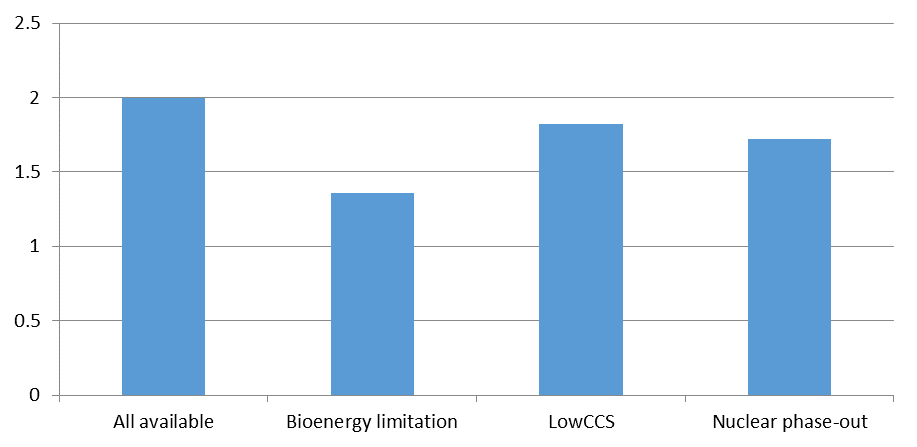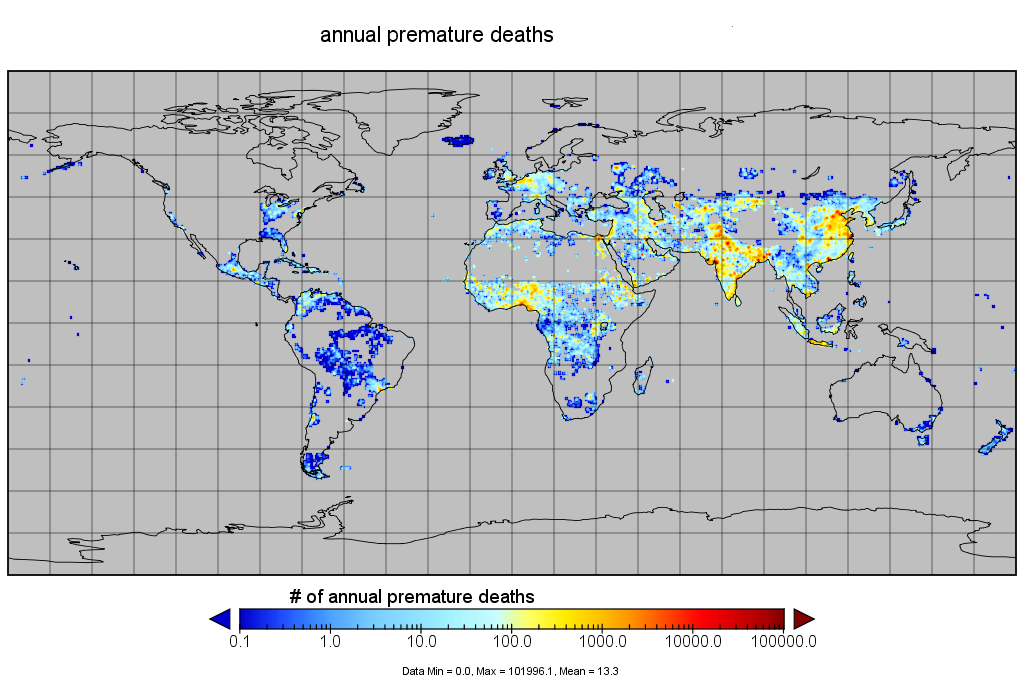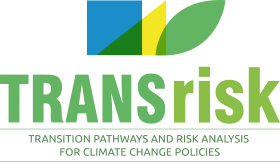If the earth’s temperature increase is limited to a maximum of 2°C premature deaths are likely to be reduced globally by 15% in 2050, from 4 million to 2.85 million. If an economic value is assigned to those premature deaths, the health co-benefit ‘savings’ are actually higher than the mitigation policy costs by a proportion ranging from 1.3 to 2, depending on the pathway. This is investigated in the Case of Santiago de Chile.
Greenhouse gas and air pollutant emissions typically share common sources, such as power plants, factories, cars and livestock. Climate change mitigation scenarios that focus on limiting greenhouse gas emissions usually also see reductions in air pollutants, due to lower use of combustion sources, increased use of cleaner fuels and greater energy efficiency.
Global Health Impacts
Our research linked an Integrated Assessment Model with a high-quality source-receptor model, to examine the health co-benefits of various mitigation pathways. In a scenario where climate change is limited to a maximum of 2°C (with all the technologies available) premature deaths are likely to be reduced globally by 15% in 2050, from 4 million to 2.85 million.

If an economic value is assigned to those premature deaths (based on the value of statistical life) the health co-benefit ‘savings’ are actually higher than the mitigation policy costs by a proportion ranging from 1.3 to 2, depending on the pathway.
This finding has important implications: the global costs of limiting climate change to 2ºC will be more than offset by the monetised health benefits from air quality improvements. This means policies can often be justified on health grounds alone, even before the climate change mitigation impacts are taken into account.
The geographical dispersion of these costs and benefits are, however, uneven. In Europe and most of Asia health benefits outweigh the costs of mitigation, most significantly in India (by 5 times) and China (by 2.8 times). In the rest of the world mitigation costs are higher than the health co-benefit foreseen.

This geographical variation is largely a factor of population density. For example, air pollutants emitted into densely populated cities affect a far larger number of people than if they were emitted into a rural area. The health cost of air pollutants in heavily populated areas are therefore far higher.
In addition to mortality impacts there is also compelling evidence of the impact of poor air quality on morbidity, especially in the case of vulnerable groups such as children. Clinically healthy children living in a highly polluted urban environment exhibit deficits in fluid cognition, memory, and executive functions compared to healthy children living in less polluted environments.
Poor air quality also has a direct economic impact by affecting worker productivity and job absenteeism. There is compelling evidence supporting a large correlation between job absenteeism and poor air quality.
The Case of Santiago de Chile
Santiago de Chile is a good example of a highly populated, polluted city. It was one of the most polluted cities in Latin America at the beginning of the 1990s, and the Chilean Government has introduced an air quality plan (“Santiago Respira”) in response.
Estimates of premature deaths due to poor air quality in Chile as a whole vary from 5,900 (Health Effects Institute) to 2,822 (WHO). Poorer areas are disproportionately affected by poor air quality: vulnerable areas of Chile are more likely to exceed the national 24-hour standard for fine particles, and have longer time periods of unhealthy air (21% more days with higher levels of air pollution).

The “Santiago Respira” plan has been developed to achieve national air quality targets for PM2.5, PM10, O3, CO, NO2 and SO2 gases, over a 10 year time period (2016-2026). Our analysis shows that two policies are expected to have the most significant impact on emissions of PM2.5 and NOx: (i) improved technological standards for Transantiago’s bus fleet and, (ii) the creation of a Low Emissions Zone within the ring formed by the Americo Vespucio Avenue.
To date our research judged Santiago’s management of short-term air pollution episodes to be successful, however longer term air quality management has been less successful mainly because of a lack of commitment in the implementation of new policies. More promisingly, stricter goals regarding the use of less polluting vehicles, seems to be a successful path to achieve a long-term reduction in pollution.
Omissions in “Santiago Respira” include one of the main sources of pollution: household burning of firewood. We also identified that public transportation as a tool to reduce environmental pollution is underutilised. However, if the quality of public transportation improves, we would expect a large substitution from private cars to public transportation, which would reduce emissions.
To provide a comparison, we compared air quality management in Chile with the more mature framework of the U.S. State of California, which has similar climate and geography to Chile. California and Chile both make special efforts on the regulation of mobile sources (such as road vehicles) due to their significant contribution to air pollution. However, California’s regulation of stationary sources is far more effective due to a combination of institutional strength (monitoring systems with good frequency and quality data) with flexible use of tradable emission permits.
Air Pollution Impacts on Climate Change
In addition to its impact on human health, particulate matter also has an impact on climate change. Particles can either absorb or reflect light depending on their colour (albedo), which can either enhance or moderate temperature increases. When compared to carbon dioxide or methane emissions the effect is short-lived, as particulate matter is removed from the atmosphere relatively quickly, but in the case of dark particles (“black carbon”) the impact is significant. Indeed, there is strong evidence that black carbon is the second largest contributor of greenhouse effect, after CO2.
In the case of Chile, more than half of PM2.5 is emitted from mobile combustion sources (diesel and gasoline) or households (combustion of firewood), all of which are rich emitters of black carbon. As the Chilean government states in their Intended Nationally Determined Contribution, black carbon is a significant part of PM2.5 in Chilean cities.
The impact of black carbon shows that policy co-benefits can, in some cases, work both ways: climate mitigation policies can lead to health co-benefits but also health policies can lead to mitigation co-benefits. Integrated policies seeking to mitigate climate change and improve air quality are logically the most preferred option.

This article is an output of the EU-funded TRANSrisk project. It is derived from work undertaken for Deliverable 4.4 “Synergies and Conflicts of Different Transition Pathways” , specifically two papers “Health co-benefits associated with different transition pathways” and “Socioeconomic impacts of air pollution in the Chilean metropolitan area”. These papers, which are fully referenced, and other TRANSrisk outputs can be downloaded from the project website. Smog photo by Yym1997 – Own work, CC BY-SA 3.0.
TRANSrisk
Project details
- Project title: “Transitions Pathways and Risk Analysis for Climate Change Mitigation and Adaption Strategies” (TRANSrisk)
- Funding scheme: European Union Horizon 2020 Programme (EU H2020, grant agreement no. 642260)
- Duration: 3 years (1 September 2015 – 31 August 2018)
- Project coordinator: Science Policy Research Unit, University of Sussex, United Kingdom
- Project website: www.transrisk-project.eu



